DIVING IN THE TURKS AND CAICOS ISLANDS guarantees plenty of beauty and excitement. This British overseas protectorate entices tourists with the slogan “Beautiful by Nature.” The Caribbean waters throughout the islands offer breathtaking vertical walls, frequent close encounters with pelagics, and opportunities to observe an incredible diversity of fascinating marine life.
The two island groups of the Turks and Caicos are southeast of the Bahamas chain and north of Haiti and the Dominican Republic. The larger Caicos Island group is to the west, and the Turks Island group is to the east. The Turks Island Passage, a deepwater channel about 22 miles wide, separates them.
The third-largest island, Providenciales — also known as Provo, is the center of development, tourism, and economic activity and home to the international airport. Grace Bay, on Provo’s north shore, is consistently rated as one of the world’s most popular beaches. Dive operations are on four islands: Providenciales, South Caicos, Grand Turk, and Salt Cay.
PROVO
Most divers who visit Turks and Caicos stay on Providenciales or dive from one of the liveaboard dive boats operating from the island. The focus is diving the northwest end of Provo and the uninhabited West Caicos and French Cay islands.
More than a dozen interesting wall dive sites are located along a 3-mile stretch of Provo’s west end known as Northwest Point. These sites have magnificent formations of colorful tube sponges, elephant ear sponges, and massive barrel sponges. The sponges serve as a backdrop for the residents, which include eagle rays, turtles, moray eels, schools of fish, and reef sharks.
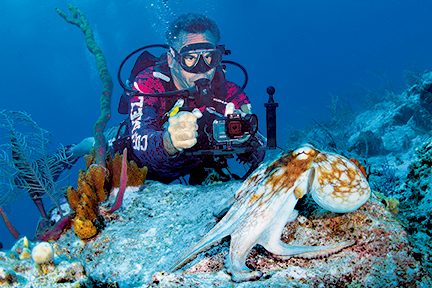
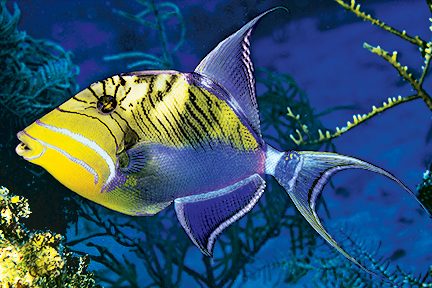
The expansive sand flats of the shallow back reefs are home to garden eels. Large southern rays cruise these areas hunting the eels, so it is easy to get close to them while they fixate on dinner. Octopuses and eels are often out in the open during night dives, while black jacks and barracudas swim in and out of the beams of dive lights and use the illumination to help spot prey.
The northernmost sites regularly experience some current. These sites have exaggerated spur-and-groove formations between 40 and 70 feet that are heavily decorated with assorted soft corals, which thrive in these currents.
One of the most popular and unique dive sites at Northwest Point is Thunderdome, which was once part of the set of a show called The Treasure of Pago Pago. This game show was filmed in the Turks and Caicos and aired on French television in 1993 and 1994. Contestants competed to win the opportunity to freedive into a large dome structure and gather pearls that a metal device resembling a stove-pipe sponge cast into the water. The contestants could trade pearls for a breath of air from a scuba tank. The show was canceled after several contestants suffered air embolisms and similar air-expansion medical issues. Fortunately, the show had no recorded deaths.
The dome originally sat on a flat sand bottom at a depth of 35 feet with its top at 15 feet. The heavy, metal-mesh dome structure collapsed in 2004 during Hurricane Frances, leaving several pieces of the structure scattered about the bottom. This debris field attracts a wide variety of marine life, including schools of fish, large groupers, nurse sharks, moray eels, and the occasional sea turtle, all of which seek refuge under and around the various fragments of the dome. Divers also consider Thunderdome one of the top night dives at Northwest Point because it offers an assortment of macro subjects for photographers. Although it failed miserably as a TV game show, it excels as a dive site.
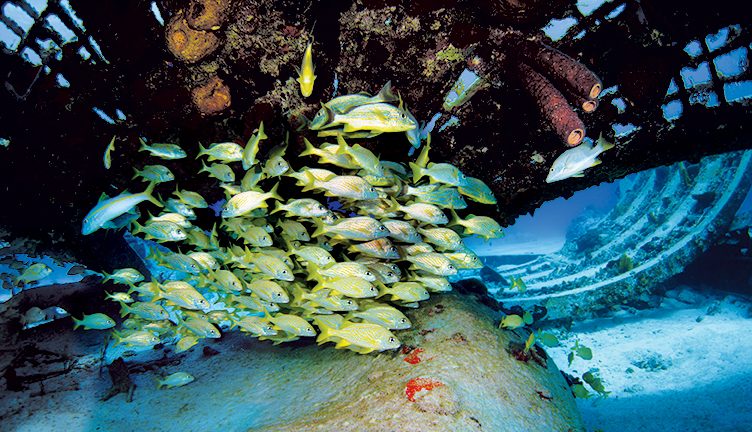
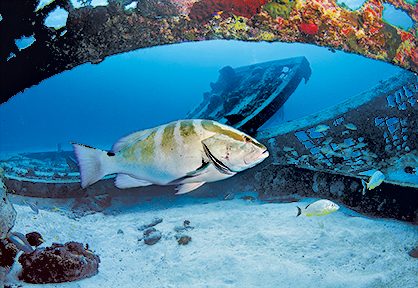
Northwest Point has many excellent wall dives, including Amphitheater, The Crack, Coral Stairway, and Hole in the Wall. These sites offer an array of canyons, undercuts, and pinnacles that break up the sheer, vertical walls. Cleaning stations full of hard-working cleaners are common. Massive barrel sponges and colorful tube sponges leaning out from the walls are excellent subjects for wide-angle photography. In most places, the tops of the walls are only 35 to 40 feet deep. Caribbean reef sharks and eagle rays enjoy cruising slowly along the walls and will often approach divers.
When it is time to return to the shallows, divers can often encounter schools of snappers, schoolmasters, and grunts congregating around small coral heads. Permanent moorings are a short distance from the walls in 30 to 40 feet of water atop spur-and-groove formations. Queen triggerfish, angelfish, parrotfish, filefish, and colonies of yellowhead jawfish frequent this area. Southern stingrays with bar jacks often shadowing them are plentiful and usually too preoccupied to care about the presence of divers.

“CARIBBEAN REEF SHARKS REGULARLY CRUISE THE WALLS AND OFTEN COME TO THE SHALLOWS.”
WEST CAICOS
Liveaboards and day boats from Provo provide easy access to West Caicos, an uninhabited island southwest of Providenciales. Twelve excellent dive sites perch at intervals along the top of a wall that runs the entire length of the island only 100 to 150 yards off its western side. The spectacular wall begins between 35 and 55 feet and plummets to more than 6,000 feet.
Huge barrel sponges, magnificent deepwater sea fans, large elephant ear sponges, black corals, and healthy hard corals decorate the wall faces. Divers can see large schools of jacks, beautiful reef fish, and cleaning stations and have multiple close encounters with Caribbean reef sharks on almost every dive. The conditions here are almost always calm.
On the island’s north end, Tons of Sponges and Land of the Giants have an abundance of large, colorful sponges. Between 60 and 100 feet beautiful sponges and large deepwater gorgonian sea fans provide a living tapestry on the walls. These sites are among the few places in Turks and Caicos where you can find large pink and purple azure vase sponges. Caribbean reef sharks regularly cruise the walls and often come to the shallows. The barrel sponges here are among the largest in the Caribbean.
Elephant Ear Canyon is one of my favorite sites and always delivers plenty of photographic opportunities. The main canyon begins at the top of the wall and opens to a wide, sloping sand chute. The small critters in the seagrass include seahorses, moray eels, and jawfish aerating eggs in their mouths. The wall face tumbles in a kaleidoscopic mix of color to depths of more than 100 feet. Friendly hawksbill sea turtles are common at this site.
A few reddish-orange longsnout seahorses usually hang out near the base of Magic Mushroom, a mushroom-shaped rock that protrudes above the water just off the shoreline. These seahorses are territorial and remain in one area for long periods.
At Spanish Anchor, a large, encrusted anchor from the 1600s is clearly visible, wedged against the northern side of a sloping sand gully near where it opens onto the wall. Divers frequently see eagle rays, turtles, and sharks swimming along the drop-off. I have often discovered pairs of balloonfish engaged in various stages of mating behaviors here. These spiny puffers are among the cutest fish on the reef. As with most sites along West Caicos, large schools of horse-eye jacks wait under the dive boat during your safety stop.
“A FEW REDDISH-ORANGE LONGSNOUT SEAHORSES USUALLY HANG OUT NEAR THE BASE OF MAGIC MUSHROOM.”
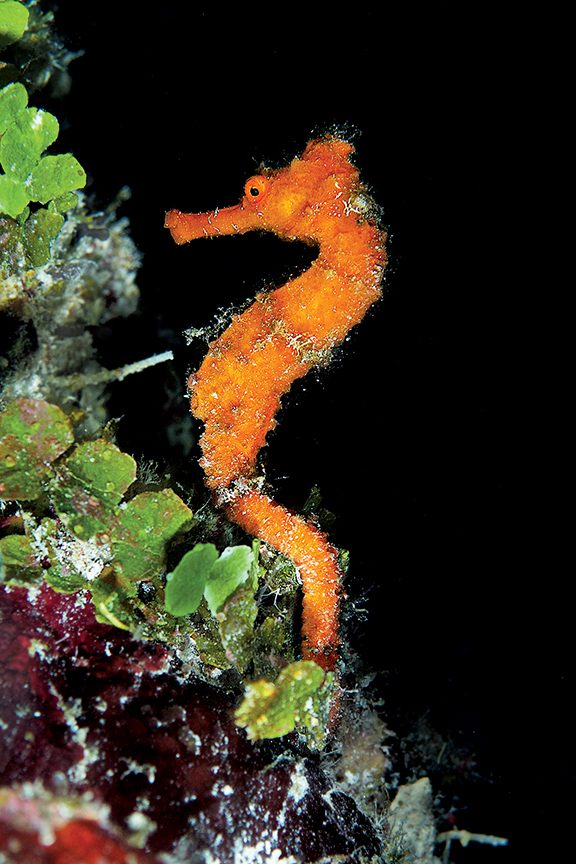
FRENCH CAY
A visit to remote French Cay is usually the highlight of any trip to Turks and Caicos. This small uninhabited sandy atoll is only a few hundred feet long on the Caicos bank’s southwest side, 18 miles southeast of West Caicos and 18 miles south of Providenciales. Remote and exposed, the dive sites here are diveable only in good weather and relatively calm conditions, but they can provide close encounters with lots of big marine life and great opportunities for wide-angle photography and video. Liveaboards frequently access this remote area, and day boats from Providenciales occasionally make the 60- to 90-minute run when conditions allow.
Double D has a lush, sloping reef with abundant marine life. Divers typically encounter Atlantic spadefish, horse-eye jacks, barracudas, turtles, eagle rays, and several large Caribbean reef sharks.
G-Spot has a large population of nurse sharks that may be snoozing or cruising about the shallow reef top, and Caribbean reef sharks patrol the shallows. On night dives, the resident nurse shark — nicknamed “Fin” for his recognizable damaged dorsal fin — is always eager to introduce his friends and family members. Reef sharks appear out of the darkness and occasionally bump into divers. Dive lights can illuminate sleeping turtles, moray eels, and octopuses.
At Half Mile Reef the friendly Caribbean reef sharks often appear to be escorting buddy teams of divers around the reef top. Stingrays, schools of reef fish, and various jacks are almost always within view.

I have often discovered pairs of balloonfish engaged in various stages of mating behaviors here. These spiny puffers are among the cutest fish on the reef.
SOUTH CAICOS
Only a 20-minute flight to the southeast of Provo, South Caicos is a destination without crowds. Although there are few places to stay, a dive resort has recently moved to the island, and its owners have explored and meticulously mapped some dive areas that will soon be available.
Some established dive sites offer fascinating topography and encounters with large pelagics. The Grotto features swim-throughs, a wall, and encounters with eagle rays, horse-eye jacks, turtles, and occasional reef sharks. Roughtail stingrays scattered around the medium-deep sand flats are a highlight of this dive. Eagle Ray Alley and nearby Dove Cay have shallow dives where you can frequently encounter squadrons of eagle rays. There are a few majestic stands of elkhorn corals at Dove Cay.
Divers will find an assortment of coral-encrusted anchors at Lost Anchors, and it is not uncommon to see octopuses here during the day. An assortment of jacks, margates, and schoolmasters fills The Arch. The surrounding area has plentiful marine life, including large barrel and tube sponges, lobsters, schools of fish, and southern rays and jawfish along the sand flats.
THE TURKS ISLAND GROUP
The Turks Island Group is composed of Grand Turk and Salt Cay. Grand Turk supports a great, laid-back dive culture with a couple of small resorts and dive operations. Salt Cay, a small island south of Grand Turk, is reachable by ferry but has limited dive services.
Turks Island diving is some of the best in the Caribbean. These islands are known for their crystal-clear waters, diverse marine life, and dramatic walls. Most of the sites are on the edge of the drop-off that runs along the leeward side of the islands, just off the western shorelines. The transitions from the shallow areas, typically spur-and-groove formations at 25 to 40 feet, are abrupt in most places and give way to vertical walls that feature steep canyons, arches, sand chutes, overhangs, and swim-throughs. The underwater visibility is generally excellent because there is very little runoff.
These waters support high fish densities and many healthy hard and soft corals. The healthy reef environment features friendly Nassau groupers, schools of blue tangs, colorful queen triggerfish, pairs of spotted and scrawled filefish, and inquisitive angelfish, among others. Larger marine life such as stingrays, various sea turtles, and spotted eagle rays are common, but reef sharks are less populous here than in other areas of Turks and Caicos.
At the north end of the Grand Turk wall, Aquarium has vast numbers and varieties of fish, including large schools of ocean triggerfish, schoolmasters, crevalle jacks, blue runners, yellowtail snappers, and barracudas. Continuing south to McDonald’s is an arch big enough for two divers to swim through comfortably, forming an open gateway to the drop-off.
Amphitheater is named for a bowl-shaped structure cut into the wall and has a sand bottom partially surrounded by a semicircular coral ridge. Black coral branches, deepwater sea fans, and tube sponges cover the wall surrounding the bowl. A massive mound covered with red deepwater gorgonians sits in 80 feet of water at Finbars Reef.
One of my favorite sites in this area is The Library, a shallow wall dive immediately offshore from Cockburn Town on Grand Turk. This incredible macro dive includes subjects such as the fascinating orange ball corallimorphs, which look like anemones with transparent tentacles sporting a bright orange ball. You can also find nudibranchs, octopuses, orange Tubastrea cup corals, and slipper lobsters.
Point Pleasant, a shallow dive at the north end of Salt Cay, has a few beautiful stands of pillar and elkhorn corals. Encounters with eagle rays, tarpons, nurse sharks, African pompanos, and other large jacks are common at this site. There are large deepwater gorgonians, black coral trees, and pillar corals in large numbers at the Rookery and Kelly’s Folly.
Many visitors stay in Grand Turk and Salt Cay in the winter to snorkel with the humpback whales that migrate through the passage just west of Grand Turk and Salt Cay from late January to early April. AD
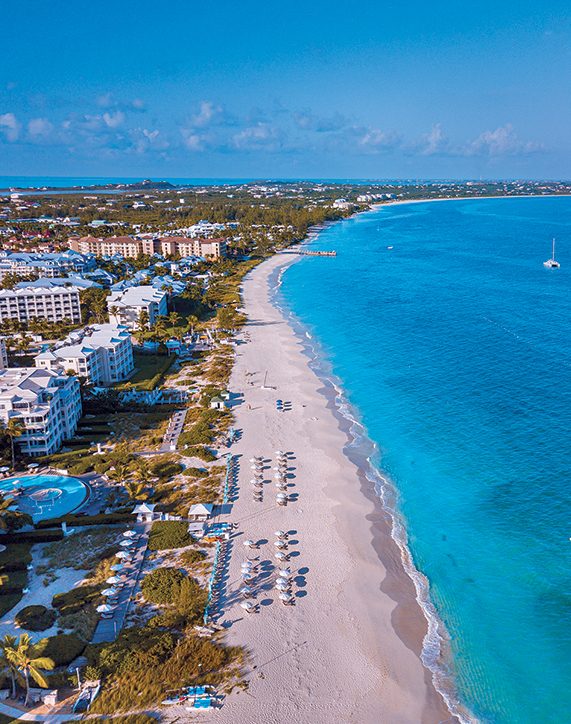
How to Dive It
Getting there:
Getting to the Turks and Caicos Islands via the Providenciales International Airport (PLS) is easy. Direct flights are available from many U.S. gateway cities through several major carriers.
Visitors can get to the other islands in Turks and Caicos by ferry or interisland flights. Several islands, including Grand Turk, Salt Cay, and South Caicos, have domestic airports serviced by Caicos Express Airways and InterCaribbean Airways daily or semiweekly. Travelers should check with the airline, dive resort, or tour operator to find out if carry-on or checked baggage has weight and size restrictions.
Conditions:
The water temperature in Turks and Caicos ranges from about 74°F to 78°F in the winter to 82°F to 84°F in the summer. The underwater visibility is excellent, often exceeding 100 feet.
The Turks and Caicos Islands enjoy year-round sunshine with prevailing easterly breezes from the trade winds. The islands generally have a dry season from late winter through early summer and more precipitation from late summer to early winter. The average air temperatures range from 80°F to 90°F throughout the year. Hurricane season is June through November, and tourism is most active between December and April.
Explore More
Discover more of the natural beauty of Turks and Caicos by viewing this online gallery and visiting turksandcaicostourism.com.
© Alert Diver — Q3 2023
